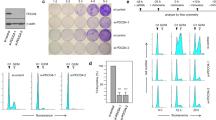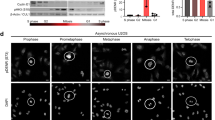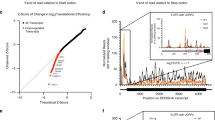Abstract
The Pdcd4 gene has originally been isolated in a search for genes that are activated in cells undergoing apoptosis. Independent of these studies, the Pdcd4 gene has been implicated in the suppression of tumor-promoter-mediated transformation of keratinocytes and as a downstream target of Myb in hematopoietic cells. The Pdcd4 protein has weak homology to the eucaryotic translation initiation factor eIF4G and has been shown to interact with certain translation initiation factors. To explore the molecular function of the Pdcd4 protein, we have studied its subcellular localization. We show that the Pdcd4 protein is a predominantly nuclear protein under normal growth conditions and that it is exported from the nucleus by a leptomycin B-sensitive mechanism upon serum withdrawal. The protein contains two nuclear export signals, one of which is very potent. In addition, we demonstrate that the Pdcd4 protein has RNA-binding activity and that the sequences involved in RNA-binding are located in the amino-terminal part of the protein. Taken together, our data raise the possibility that Pdcd4 is involved in some aspect of nuclear RNA metabolism in addition to its suspected role in protein translation.
This is a preview of subscription content, access via your institution
Access options
Subscribe to this journal
Receive 50 print issues and online access
$259.00 per year
only $5.18 per issue
Buy this article
- Purchase on Springer Link
- Instant access to full article PDF
Prices may be subject to local taxes which are calculated during checkout




Similar content being viewed by others
References
Appl H and Klempnauer K-H . (2002). Oncogene, 21, 3076–3081.
Cmarik JL, Min H, Hegamyer G, Zhan S, Kulesz-Martin M, Yoshinaga H, Matsuhashi S and Colburn NH . (1999). Proc. Natl. Acad. Sci. USA, 96, 14037–14042.
Elfgang C, Rosorius O, Hofer L, Jaksche H, Hauber J and Bevec D . (1999). Proc. Natl. Acad. Sci. USA, 96, 6229–6234.
Fornerod M, Ohno M, Yoshida M and Mattaj IW . (1997). Cell, 90, 1051–1060.
Fukuda M, Asano S, Nakamura T, Adachi M, Yoshida M, Yanagida M and Nishida E . (1997). Nature, 390, 308–311.
Göke A, Göke R, Knolle A, Trusheim H, Schmidt H, Wilmen K, Carmody R, Göke B and Chen YH . (2002). Biochem. Biophys. Res. Commun., 297, 78–82.
Henderson BR and Eleftheriou A (2000). Exp. Cell Res., 256, 213–224.
Hentze MW and Kuloznik AE . (1999). Cell, 96, 307–310.
Kang MJ, Ahn HS, Lee JY, Matsuhashi S and Park WY . (2002). Biochem. Biophys. Res. Commun., 293, 617–621.
Lipsick JS and Wang D-M . (1999). Oncogene, 18, 3047–3055.
Lykke-Andersen J . (2001). Curr. Biol., 11, R88–R91.
Maquat LE and Carmichael GG . (2001). Cell, 104, 173–176.
McKendrick L, Thompson E, Ferreira J, Morley SJ and Lewis JD . (2001). Mol. Cell. Biol., 21, 3632–3641.
Moscovici C, Moscovici MG, Jiminez H, Lai MMC, Hayman MJ and Vogt PK . (1977). Cell, 11, 95–103.
Nishi K, Yoshida M, Fujiwara D, Nishikawa M, Horinouchi S and Beppu T . (1994). J. Biol. Chem., 269, 6320–6324.
Oh I-H and Reddy EP . (1999). Oncogene, 18, 3017–3033.
Patel DJ . (1999). Curr. Opin. Struct. Biol., 9, 74–87.
Perez-Canadillas JM and Varani G . (2001). Curr. Opin. Struct. Biol., 11, 53–58.
Schell T, Kuloznik AE and Hentze MW . (2002). Genome Biol., 3, 1006.
Schlichter U, Burk O, Worpenberg S and Klempnauer K-H . (2001a). Oncogene, 20, 231–239.
Schlichter U, Kattmann D, Appl H, Miethe J, Brehmer-Fastnacht A and Klempnauer K-H . (2001b). Biochim. Biophys. Acta, 1520, 99–104.
Shibahara K, Asano M, Ishida Y, Aoki T, Koike T and Honjo T . (1995). Gene, 166, 297–301.
Wagner C, Steffen R, Koziol C, Batel R, Lacorn M, Steinhart H, Simiat T and Mueller WEG . (1998). Mar. Biol., 131, 411–421.
Weiss MA and Narayana N . (1999). Biopolymers, 48, 167–180.
Wen W, Meinkoth JL, Tsien RY and Taylor SS . (1995). Cell, 82, 463–473.
Weston K . (1999). Oncogene, 18, 3034–3038.
Yang H-S, Jansen AP, Nair R, Shibahara R, Verma AK, Cmarik JL and Colburn NH . (2001). Oncogene, 20, 669–676.
Yang HS, Jansen AP, Komar AA, Zheng X, Merrick WC, Costes S, Lockett SJ, Sonenberg N and Colburn NH . (2003). Mol. Cell. Biol., 23, 26–37.
Yoshinaga H, Matsuhashi S, Fujiyama C and Masaki Z . (1999). Pathol. Int., 49, 1067–1077.
Acknowledgements
We thank Bianca Michaelis and Dorit Wenning for excellent technical assistance, Sebastian Horstmann for valuable advice and discussions and Minoru Yoshida for a generous gift of leptomycin B. This work was supported by an ERASMUS-fellowship from the EU to KS and by grants from the Deutsche Krebshilfe (10-1716) and the Fonds der chemischen Industrie to K-HK.
Author information
Authors and Affiliations
Corresponding author
Rights and permissions
About this article
Cite this article
Böhm, M., Sawicka, K., Siebrasse, J. et al. The transformation suppressor protein Pdcd4 shuttles between nucleus and cytoplasm and binds RNA. Oncogene 22, 4905–4910 (2003). https://doi.org/10.1038/sj.onc.1206710
Received:
Revised:
Accepted:
Published:
Issue Date:
DOI: https://doi.org/10.1038/sj.onc.1206710
Keywords
This article is cited by
-
Human tumor suppressor PDCD4 directly interacts with ribosomes to repress translation
Cell Research (2024)
-
PDCD4 limits prooncogenic neuregulin-ErbB signaling
Cellular and Molecular Life Sciences (2021)
-
The HIF-1A/miR-17-5p/PDCD4 axis contributes to the tumor growth and metastasis of gastric cancer
Signal Transduction and Targeted Therapy (2020)
-
PDCD4 controls the G1/S-phase transition in a telomerase-immortalized epithelial cell line and affects the expression level and translation of multiple mRNAs
Scientific Reports (2020)
-
Cytoplasmic localization of programmed cell death 4 contributes to its anti-apoptotic function
Molecular and Cellular Biochemistry (2018)



